Samsung Galaxy Note 8.0 Review
by Anand Lal Shimpi on April 17, 2013 11:29 PM EST- Posted in
- Tablets
- Samsung
- Android
- Mobile
- Galaxy Note 8.0
The Display
The Note 8.0 holds a slight pixel density advantage over the iPad mini (189 ppi vs. 163 ppi). Just like the earliest Android tablets that held a similar pixel density advantage (~13%), the improvement is noticeable. At the price point and device size however, the Note 8.0 remains under-specced. Just as the iPad mini would benefit from a Retina class display, the Galaxy Note 8.0 could use a 1080p panel as well. Given we're seeing flagship ~5" Android smartphones ship with 1080p displays, a flagship 8" tablet should meet the same criteria.
Unfortunately one of the hallmarks of TouchWiz is that all icons and widgets are considerably larger than they are under iOS, which results in a lot of wasted space on the 8-inch 1280 x 800 display. Despite having a larger display, higher resolution and higher pixel density, I feel more cramped on the Galaxy Note 8.0 than I do on the iPad mini. I understand this is a conscious design decision by Samsung and I can definitely see larger icons, fonts and touch targets resonating very well with certain demographics, but at the same time I believe the design decision flies in the face of what Samsung is hoping to accomplish with the Note family.
The Note 8.0 can get very bright, but black levels suffer as a result. Overall contrast ratio is a bit better than the iPad mini, but I'd prefer better black levels to absurdly high white levels. The latter can help improve readability outdoors, but even cranked all the way up you'll have issues in direct sunlight.
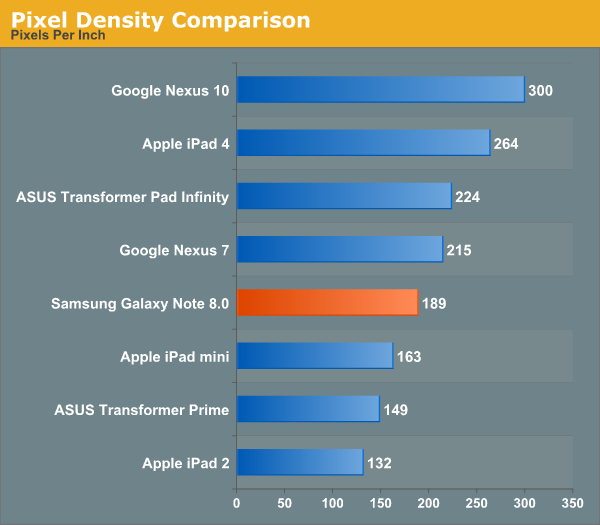
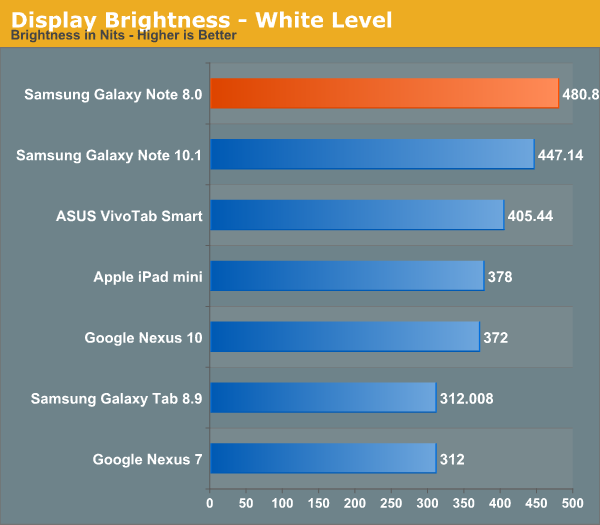
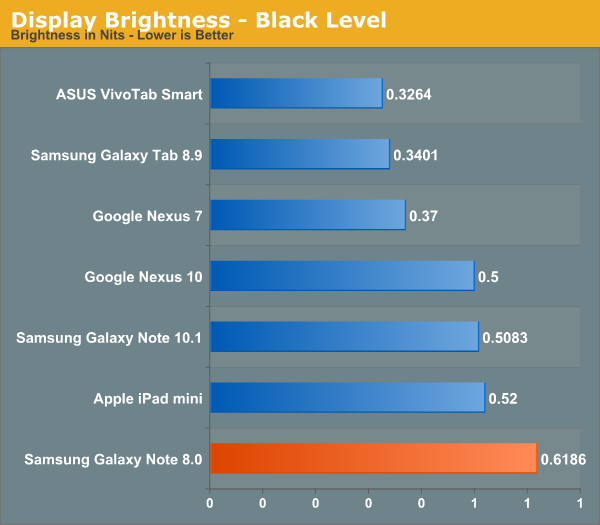
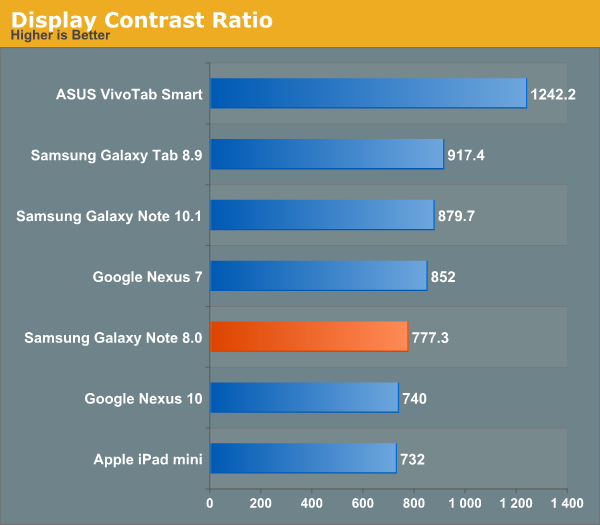
The Galaxy Note 8.0 uses a standard LED backlit LCD display instead of the AMOLED based panels common in Samsung’s smartphones. The departure is a welcome change in my opinion as the Note 8’s avoids Samsung’s AMOLED color calibration tendencies. In fact, the Galaxy Note 8.0’s display performed very similarly to the iPad mini in our color accuracy tests:
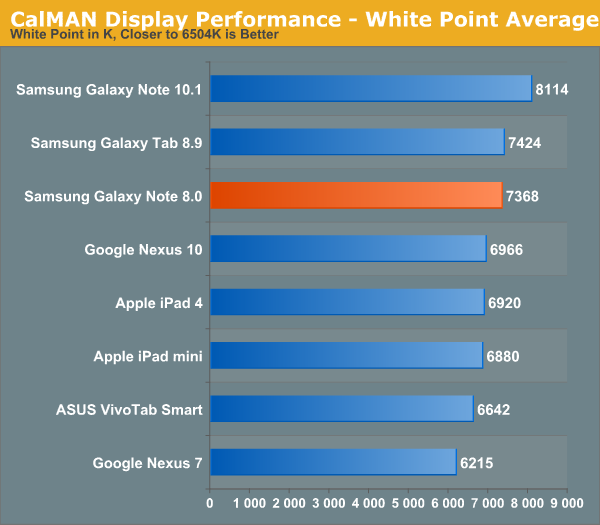
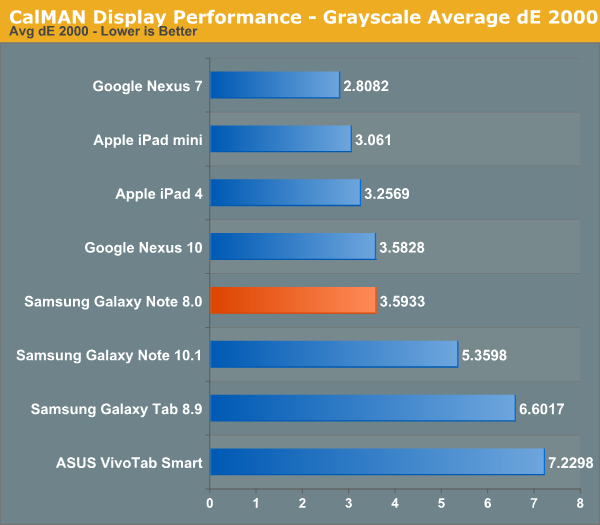

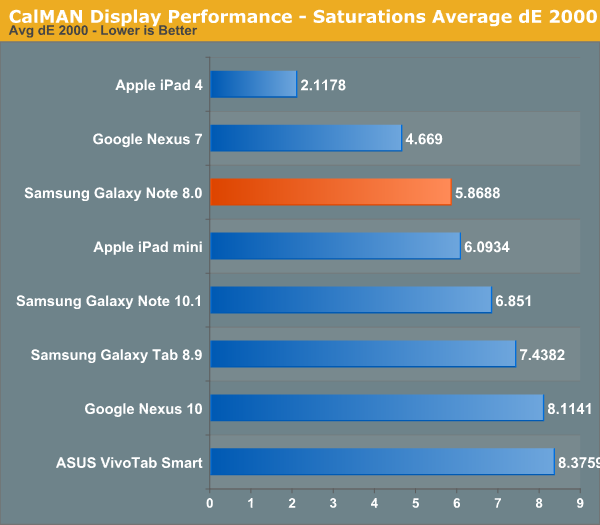

The mini doesn’t feature as accurate of a display as the bigger Retina iPads, which gives the Note 8 a lower target to shoot for, but its performance is admirable nonetheless.
Samsung does offer a couple of display presets on the Note 8, similar to what it does on other platforms. Choosing between Dynamic, Standard and Movie modes plays around with white points and color balance a bit. The standard setting is pretty good out of the box, although movie mode does move the white point closer to 6500K and improved color accuracy by a little bit.
The Note 8’s software build also ships with support for a reader mode that further warms up the white point in an attempt to make reading text easier on your eyes. In an attempt to bring as much of the PC experience as possible to Android tablets, Samsung bombards you with customization options - including the ability to select which applications use reader mode when it’s enabled. You can’t enable reader mode for all apps, but 3rd party apps are supported.


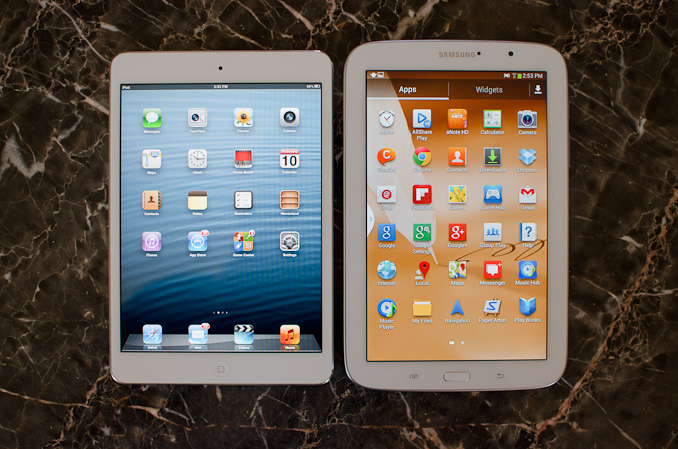











95 Comments
View All Comments
teiglin - Thursday, April 18, 2013 - link
I'm not sure there's a reasonable compromise there, though, without increasing size pretty substantially. Even APQ8064 at 1.5GHz is going to blow through the <20Whr of battery one can fit in a chassis designed for a 7" screen very quickly, not to mention the higher draw of a denser display. Unfortunately, the reality of the OS situation means that Google lacks the luxury Apple has of running a lower-clocked CPU, so when it comes to gaming, the only way to save battery is to run games that look worse or wait for better silicon (or better battery technology, though I don't have the impression that's improving very fast).I'm curious what your target battery life is for this sort of thing. I mean, four hours is a long time to be gaming away from a power source; it's within spitting distance of long enough for a cross-country flight (sorry, US-centric here), and when travelling, I tend to have a USB battery on hand anyway.
MonkeyPaw - Thursday, April 18, 2013 - link
I suppose my thoughts are based on my first tablet, the Iconia A500. Battery life was crazy long on everything. I think I plugged it in once or twice a week, when it seems like my Nexus 7 gets plugged in almost everyday. Most days, I don't even game that long.More directly to your question, I don't have a major complaint about the Nexus 7's battery life, but I would rather see batter life improve next release as opposed to getting worse. I don't feel that the general performance of the device is bad in any way, so it seems like a more efficient SOC that performs slightly better is all that is required. Provided they don't increase DPI, of course.
Hung_Low - Thursday, April 18, 2013 - link
What is the GPS app used for the review? Seems to be very popular amongst the tech communitythebigfudge - Thursday, April 18, 2013 - link
I found it: https://play.google.com/store/apps/details?id=com....mayankleoboy1 - Thursday, April 18, 2013 - link
The only problem i see is the last generation hardware.mayankleoboy1 - Thursday, April 18, 2013 - link
Just to add, why would anyone not buy the Nexus 10 ?StormyParis - Thursday, April 18, 2013 - link
Size. Pen. SD.lmcd - Thursday, April 18, 2013 - link
Exynos 4 Quad is definitely in the good enough range.Spunjji - Friday, April 19, 2013 - link
It's probably a bit above that, being entirely honest. Tends to sit near the top end of benchmarks. Quad Krait / A6 is definitely better, but not a lot else.Spunjji - Friday, April 19, 2013 - link
Oh no, so slow./sarcasm